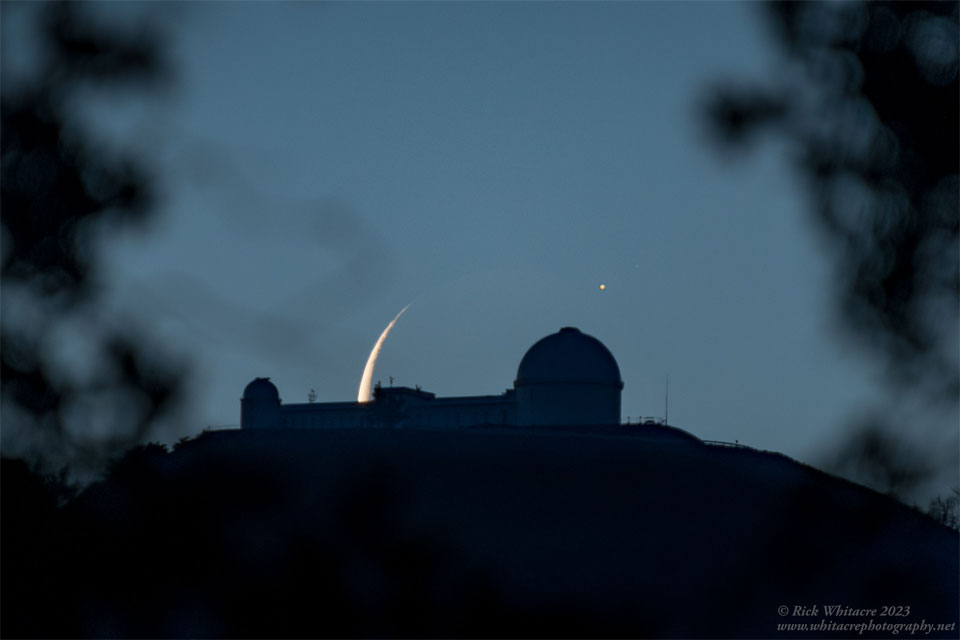24. May 2023
Kah 月掩木星 排做一逝 ê 天文台

探索宇宙1!逐工會揀一幅無仝款 ê 影像抑是相片,𤆬你熟似咱這个迷人 ê 宇宙,閣有專業天文學者2為你3解說4。
- 原始文章:Observatory Aligned with Moon Occulting Jupiter
- 影像來源 kah 版權:Rick Whitacre; 文稿:Natalia Lewandowska (SUNY Oswego)
- 相簿「2023 年 5 月 ê 月掩木星」:投稿到 APOD
- 台文翻譯:An-Li Tsai (NCU)
[漢羅] Kah 月掩木星 排做一逝 ê 天文台
有當時仔咱會看著 月娘 ùi 咱 太陽系 內底其中一粒行星面頭前趨過,這就叫做掩星。 發生 tī 這個月初 ê 掩星現象,閘 ê 就是木星。 這張相片 就是 木星 去予月娘閘牢了後,重新 ùi 月娘 後壁 出現 ê 時陣翕--ê。 這陣月娘 ê 月相已經來到 下月眉,閣 2 工就欲 初一 矣。 咱 ê 月娘 總是有一半去予日頭照著,毋過等到下月眉 ê 時陣,咱 tī 地球 看,嘛干焦看會著彼半爿月娘 ê 一部份爾爾。 Tī 這張相片內底,月娘就排 tī 美國 加州 Hamilton 山頂 彼个有名 ê Lick 天文台 後壁。 是講誠拄好,Lick 天文台 是發現木星 ê 衛星 木衛五 Amalthea ê 所在,是 Galileo 觀測著 木星四大衛星了後,上尾一粒用目睭揣著 ê 衛星。
[POJ] Kah Goe̍h-iám-bo̍k-chheⁿ pâi chò chi̍t chōa ê Thian-bûn-tâi
Ū-tang-sî-á lán ē khòaⁿ-tio̍h goe̍h-niû ùi lán thài-iông-hē lāi-té kî-tiong chi̍t-lia̍p kiâⁿ-chheⁿ bīn-thâu-chêng chhu kòe, che to̍h kiò-chò Iám-chheⁿ. Hoat-seng tī chit kò goe̍h chhe ê Iám-chheⁿ hiān-siōng, cha̍h ê to̍h sī Bo̍k-chheⁿ. Chit tiuⁿ siòng-phìⁿ to̍h sī Bo̍k-chheⁿ khì hō͘ goe̍h-niû cha̍h-tiâu liáu-āu, tiông-sin ùi goe̍h-niû āu-piah chhut-hiān ê sî-chūn hip--ê. Chit-chūn goe̍h-niû ê goe̍h-siòng í-keng lâi kàu ē-goe̍h-bâi, koh 2 kang to̍h beh chhe-it ah. Lán ê goe̍h-niû chóng--sī ū chi̍t-pòaⁿ khì hō͘ ji̍t-thâu chiò--tio̍h, m̄-koh tán kàu ē-goe̍h-bâi ê sî-chūn, lán tī Tē-kiû khòaⁿ, mā kan-na khòaⁿ-ē-tio̍h hit pòaⁿ-pêng goe̍h-niû ê chi̍t-pō͘-hūn niā-niā. Tī chit-tiuⁿ siòng-phìⁿ lāi-té, goe̍h-niû to̍h pâi tī Bí-kok Ka-chiu Hamilton soaⁿ-téng hit-ê ū-miâ ê Lick thian-bûn-tâi āu-piah. Sī kóng chiâⁿ tú-hó, Lick thian-bûn-tâi sī hoat-hiān Bo̍k-chheⁿ ê ūi-chheⁿ Bo̍k-ūi-gō͘ Amalthea ê só͘-chāi, sī Galileo koan-chhek tio̍h Bo̍k-chheⁿ sì tōa ūi-chheⁿ liáu-āu, siōng bóe chi̍t-lia̍p iōng ba̍k-chiu chhōe--tio̍h ê ūi-chheⁿ.
[KIP] Kah Gue̍h-iám-bo̍k-tshenn pâi tsò tsi̍t tsuā ê Thian-bûn-tâi
Ū-tang-sî-á lán ē khuànn-tio̍h gue̍h-niû uì lán thài-iông-hē lāi-té kî-tiong tsi̍t-lia̍p kiânn-tshenn bīn-thâu-tsîng tshu kuè, tse to̍h kiò-tsò Iám-tshenn. Huat-sing tī tsit kò gue̍h tshe ê Iám-tshenn hiān-siōng, tsa̍h ê to̍h sī Bo̍k-tshenn. Tsit tiunn siòng-phìnn to̍h sī Bo̍k-tshenn khì hōo gue̍h-niû tsa̍h-tiâu liáu-āu, tiông-sin uì gue̍h-niû āu-piah tshut-hiān ê sî-tsūn hip--ê. Tsit-tsūn gue̍h-niû ê gue̍h-siòng í-king lâi kàu ē-gue̍h-bâi, koh 2 kang to̍h beh tshe-it ah. Lán ê gue̍h-niû tsóng--sī ū tsi̍t-puànn khì hōo ji̍t-thâu tsiò--tio̍h, m̄-koh tán kàu ē-gue̍h-bâi ê sî-tsūn, lán tī Tē-kiû khuànn, mā kan-na khuànn-ē-tio̍h hit puànn-pîng gue̍h-niû ê tsi̍t-pōo-hūn niā-niā. Tī tsit-tiunn siòng-phìnn lāi-té, gue̍h-niû to̍h pâi tī Bí-kok Ka-tsiu Hamilton suann-tíng hit-ê ū-miâ ê Lick thian-bûn-tâi āu-piah. Sī kóng tsiânn tú-hó, Lick thian-bûn-tâi sī huat-hiān Bo̍k-tshenn ê uī-tshenn Bo̍k-uī-gōo Amalthea ê sóo-tsāi, sī Galileo kuan-tshik tio̍h Bo̍k-tshenn sì tuā uī-tshenn liáu-āu, siōng bué tsi̍t-lia̍p iōng ba̍k-tsiu tshuē--tio̍h ê uī-tshenn.
[English] Observatory Aligned with Moon Occulting Jupiter
Sometimes we witness the Moon moving directly in front of -- called occulting -- one of the planets in our Solar System. Earlier this month that planet was Jupiter. Captured here was the moment when Jupiter re-appeared from behind the surface of our Moon. The Moon was in its third quarter, two days before the dark New Moon. Now, our Moon is continuously half lit by the Sun, but when in its third quarter, relatively little of that half can be seen from the Earth. Pictured, the Moon itself was aligned behind the famous Lick Observatory in California, USA, on the summit of Mount Hamilton. Coincidentally, Lick enabled the discovery of a moon of Jupiter: Amalthea, the last visually detected moon of Jupiter after Galileo's observations.
詞彙學習
| 漢羅 | POJ | KIP | 華語 | English |
|---|---|---|---|---|
| 月掩木星 | Goe̍h-iám-bo̍k-chheⁿ | Gue̍h-iám-bo̍k-tshenn | 月掩木星 | Moon Occulting Jupiter |
| 掩星 | iám-chheⁿ | iám-tshenn | 掩星 | occultation |
| 木星 | Bo̍k-chheⁿ | Bo̍k-tshenn | 木星 | Jupiter |
| 月相 | goe̍h-siòng | gue̍h-siòng | 月相 | moon phase |
| 初一 | chhe-it | tshe-it | 新月 | new moon |
| 木衛五 Amalthea | Bo̍k-ūi-gō͘ Amalthea | Bo̍k-uī-gōo Amalthea | 木衛五 阿摩笛亞 | Amalthea |
| 太陽系 | thài-iông-hē | thài-iông-hē | 太陽系 | Solar System |